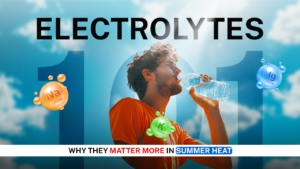
Until now, we have seen that an improvement in the oxygen carrying ability is an important factor contributing to peak performance in endurance sport, since it is heavily dependent on the oxidative energy system (Oxygen dependent). Athletes can see significant improvements in the cardiopulmonary system and oxygen carrying capabilities of the body through regular training, implying 30-45 minutes per session and a minimum of 3 to 5 training sessions per week for at least 8 weeks.
High Altitude Training is one such modality through which the oxygen transport within the body could be improved, this type of training causes an increase in red blood cells and haemoglobin molecules, which results in an increased capacity to bring oxygen to the working muscles. However, most athletes do not find time or have access to resources for a duration long enough to bring about a significant increase in RBCs or haemoglobin.
Unfortunately, the same physiological adaptations can also be induced by using illegal pharmacological ergogenic aids, most commonly known as the recombinant human erythropoietin (rhEPO).
However, athletes must keep in mind that following a well planned and scientifically sound training program will achieve several positive cardiopulmonary adaptations while training at sea level as well.
The beneficial adaptations of regular Endurance training include the following:
- Decrease in Resting and Exercise Heart Rate.
- Increase in total blood volume.
- Increase in Cardiac Output.
- Increase in maximal oxygen uptake (VO2 Max) and exercise respiratory capacity.
- Improved Lactate Threshold.
- Improved maximal exercise performance and and exercise economy.
- Improved heat tolerance.
- Decreased total body weight.
- Decrease in body fat percentage.
- Control blood pressure (for people with pre-existing high or moderately high blood pressure issues)
Let us see some of these benefits in greater detail in order to understand the importance of a proper training program.
Heart Rate :
With regular endurance training the heart becomes stronger due to the progressive overload it is subjected to. Since the heart gets stronger it pumps out higher volume of blood with each beat. As a result, the heart will not have to work as hard as before, and the athlete’s heart rate at rest and during exercise will be lower than before.
Example : Let’s say a person’s heart rate was 160 beats per minute (bpm) after running 500 metres on the first day. After 8 weeks of regular endurance training his heart rate should be noticeably lower post running 500 metres at the same pace as the first day of training.
The recovery heart rate also improves with regular endurance training.
Example : It took 3 minutes for a person’s heart rate to drop from 180 bpm to 120 bpm after first day of endurance training. After 8 weeks of regular endurance training his rate will drop from 180 bpm to 120 bpm in less than 3 minutes. The reduction in time will differ from person to person. Despite this individual variability, most people will see significant improvement in heart rate at rest, heart rate during exercise and heart rate recovery time, after 8 weeks of training.
Cardiac output.
Endurance training causes an increase in a few specific hormones that regulate the amount of blood in the body. The effect of this hormonal response is an increase in the total blood volume.
A stronger heart along with increased blood volume results in more blood being pumped over a specific period of time at the same heart rate. This increase in the amount of blood pumped over a specific period of time is referred to as increase in Cardiac Output, it is measured as the volume of blood pumped by the heart through the body in one minute.
In endurance training increased cardiac output will ensure more oxygenated blood is delivered to the working muscles whereas carbon dioxide and other metabolic by-products are also removed rapidly.
VO2 Max
Endurance Training improves the lung capacity during exercise as well. Which implies, that the person’s respiratory rate (breaths per minute) and tidal volume (litres of air per breath) are improved. These improvements contribute to an increase in Maximal Oxygen Uptake (VO2 max). Maximal Oxygen (Vo2 max) uptake is defined as the highest volume of oxygen that a person is capable of taking in for aerobic energy production. VO2 max is expressed either in absolute units, litres of oxygen per minute (L x min -1) or relative units, millilitres of oxygen per kilogram of bodyweight per minute (ml x kg -1 x min -1). The relative units is a better measure since it allows comparisons between individuals to determine who is fitter “pound for pound”.
An improvement in VO2 max means more oxygen is available to the exercising muscles for energy production and is an important physiological factor for success in Endurance Sports.
Lactate Threshold and Maximal Exercise Performance
The Lactate Threshold is the point at which the athlete’s body relies more on the glycolysis energy system (short-term) than the oxidative phosphorylation energy system (Long-term). On reaching this point, the lactate production exceeds lactate removal, and an exponential increase in blood lactate levels is observed. The higher the lactate threshold, the better would be the endurance performance.
For evaluating lactate threshold for triathletes, running velocity (m x min-1), cycling power output (watts per kilogram of bodyweight W x kg-1), swimming velocity (m x sec-1) are the measurements of interest.
Maximal Exercise Performance (MEP) is the objective quantification of a person’s athletic capability at the point at which the person voluntarily stops exercising due to exhaustion (Volitional exhaustion). The MEP is evaluated using the same physiological measurements as used for evaluating Lactate Threshold, but they are now measured under conditions for maximal effort instead of lactate threshold effort.
By participating in a well-designed endurance training program, an athlete can see significant improvements in Maximal Exercise Performance as well as Lactate Threshold.
Physiological Economy
Physiological Economy in endurance sports is in principle similar to fuel efficiency of vehicles. A car that is more fuel efficient will use less fuel and give more kilometres per litre of fuel than a less economical car. The same is true even for endurance athletes.
Example :
Athlete A and Athlete B both have a VO2 max of 65 ml x kg-1 x min-1. Athlete A uses 52 ml x kg-1 x min-1 of oxygen while maintaining a pace of 5 minutes per mile in the first half of a 10k race. Whereas, athlete B uses 50ml x kg-1 x min-1 of oxygen at the same pace for the first half of the race.
Athlete B is likely to have a competitive edge over Athlete A in the later half of the race since he has used less fuel (oxygen) and thus is physiologically more economical.
Factors that improve Physiological Economy :
- Well-designed training program.
- Correct biomechanics.
Tolerance to Heat and Humidity
With consistent endurance training, the body produces more blood plasma and increases the total blood volume. Consider the total blood volume as radiator coolant in a car. Increase in blood volume allows an athlete to have more “radiator coolant” in the body due to which an athlete is able to produce more sweat and dissipate heat more efficiently from the body, especially while training in hot and humid conditions. This is particularly beneficial for athletes who usually compete in dry and arid environments.




